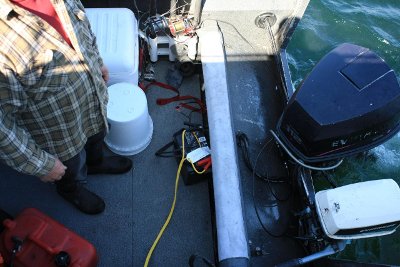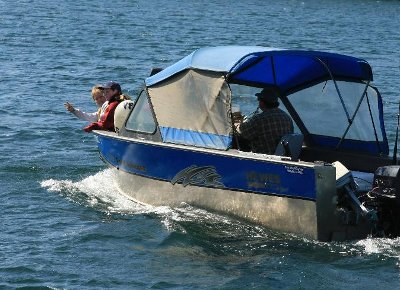

 Share This Page
Share This Page| Home | | Sailing | | Alaska 2009 | |  |  |  Share This Page Share This Page |

Copyright © 2009, P. Lutus. All rights reserved. Message Page
(double-click any word to see its definition)
Rescue!



I rescue boats whenever I can. It's a well-established tradition among boaters, and in some places, if lives are at risk, one is required to render aid. I've rescued many boats over the years, so far without any serious mishaps. This year I rescued a boat with four people on board. (My personal record for the number of people involved was a cabin cruiser with ten on board near Homer several years ago — they most likely ran out of fuel.)
As I entered a bay on Long Island near Kodiak, I saw some people waving to me from another boat. At first I thought they might be some people I had met in town wanting to visit, but as I got closer I saw there was something more frantic about their signals. After we tied together, the skipper explained that his battery was dead. He had pushed off from shore before trying to start his engine (perfectly reasonable in the case of an outboard) but he then realized the engine wouldn't start. He found himself adrift in an afternoon wind.
As it turns out, I've carried a set of jumper cables for the entire time I've owned my present boat (eight years) but never had a chance to use them. And I might never need them again. On the other hand, they aren't very heavy and don't take up much space.
I thought about the geometry — jumper cables aren't very long, my boat is pretty big, I needed the shortest path from my batteries to his. I figured out that I could route the cables from one of my batteries, through the port engine room vent, and over to the aft end of his boat — all without accidentally shorting out the cables, which could have produced a fire and disabled both our boats.
All this worked out, his engine came to life, and we had a short conversation about batteries. He thought maybe he should carry two batteries instead of one, that way he would have a spare. This idea only works if both batteries are charged regularly, which means both need to be connected all the time, which means they might as well be connected together. Which means (unless a special isolation device is present) if any of the cells in either battery goes bad, it kills both batteries. All this means either an elaborate charging system with an isolation device between two batteries, or one bigger battery.
Basically, his battery was way too small for his 112 horsepower outboard, he didn't charge it often enough or keep it on a trickle charge when it wasn't in use, and open-cell batteries like his don't last very long in the best of circumstances. But he had his own priorities and how he managed his boat was none of my business, so I kept most of this to myself.
The trick in rescuing people is to perform the rescue without being judgmental about the reasons for the emergency. But I think If I had been Gandhi I might still have wanted to offer some battery suggestions that afternoon.
Digression — batteries. We're about to see all-electric (not hybrid) cars arrive in a big way. They've begun to make sense to people, but the batteries that power them remain a perfectly terrible technology. The best available batteries have short lives, are too heavy for the energy they deliver, and are somewhat dangerous. I personally think bright young people should consider a career in materials science, learn why batteries are as bad as they are, and invent better ones.
Ordinary batteries, like the one on this man's boat, can't move an electric car very far — 800 pounds of lead-acid batteries can move a relatively small car only about 60 miles. The very best current battery technology (zinc-air) could move the same car about 360 miles, but these batteries are very expensive and can't be charged easily or very quickly.
The battery for the Tesla Roadster weighs 992 pounds and allows the car to travel 231 miles between recharges. Full recharging requires 3½ hours if 240-volt service is available. The battery alone costs $36,000. Obviously the Tesla Roadster is not the final word in economy, because it is a performance vehicle (it can reach almost 105 MPH in a quarter-mile) but it's an example of what can be achieved when cost is secondary.
In the longer term it will be interesting to see what effect mass production has on electric car technology — I suspect a dozen firms competing in an open marketplace will produce any number of interesting breakthroughs.
| Home | | Sailing | | Alaska 2009 | |  |  |  Share This Page Share This Page |